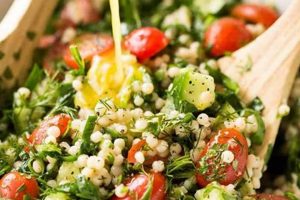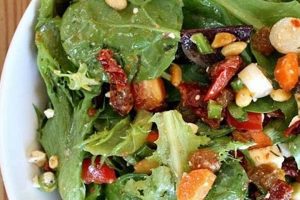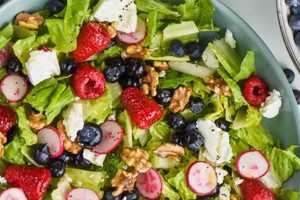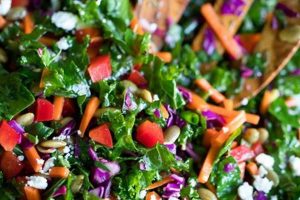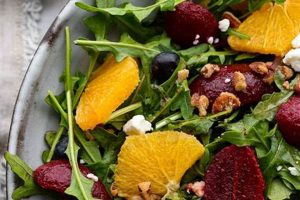Layered salads assembled in jars offer a convenient and portable meal solution. Typically, the dressing is placed at the bottom, followed by denser vegetables, grains, proteins, and lighter greens at the top. This method prevents delicate ingredients from becoming soggy and allows for customized portions. An example includes a layered salad with a vinaigrette dressing, cherry tomatoes, cucumbers, quinoa, grilled chicken, and spinach.
This approach to salad preparation offers several advantages. Maintaining freshness is paramount, and the jar method effectively keeps ingredients crisp until consumption. Portability makes these salads ideal for work lunches or picnics. Furthermore, pre-portioning assists with dietary management. This practice has gained popularity in recent years due to increased awareness of healthy eating habits and the demand for convenient meal preparation options.
The following sections will delve into specific layered salad combinations, offering diverse flavor profiles and catering to various dietary needs. Instructions will cover proper layering techniques, ingredient selection, and storage recommendations to maximize freshness and enjoyment.
Tips for Creating Layered Salads
Optimal layered salad construction requires attention to ingredient selection and layering order to maintain freshness and enhance flavor combinations.
Tip 1: Dressing First: Always start with the dressing at the bottom of the jar. This prevents other ingredients from becoming soggy.
Tip 2: Durable Vegetables Next: Layer heartier vegetables like chopped carrots, bell peppers, or cucumbers above the dressing. These act as a barrier between the dressing and more delicate ingredients.
Tip 3: Grains and Proteins in the Middle: Grains such as quinoa, rice, or pasta, along with protein sources like beans, chicken, or tofu, should be placed in the middle layer.
Tip 4: Delicate Greens on Top: Leafy greens like spinach, lettuce, or arugula should be placed at the top of the jar to prevent them from being crushed and to maintain their crispness.
Tip 5: Consider Ingredient Density: Denser ingredients should be placed lower in the jar to support the lighter ingredients above.
Tip 6: Avoid Overfilling: Leave some space at the top of the jar to allow for easy mixing when ready to eat.
Tip 7: Proper Storage is Key: Store prepared jars in the refrigerator for up to 4 days. Ensure lids are tightly sealed to maintain freshness.
By following these guidelines, one can create delicious and convenient layered salads that stay fresh and flavorful.
These practical tips provide a foundation for successful layered salad preparation, setting the stage for creative exploration and personalized meal customization.
1. Fresh Ingredients
The success of a layered salad hinges on the quality and freshness of its components. Fresh ingredients not only contribute to superior flavor and texture but also maximize nutritional value and ensure an enjoyable culinary experience. Ingredient selection is crucial for optimizing the benefits of this preparation method.
- Crisp Greens:
The foundation of any good salad lies in crisp, vibrant greens. Varieties like romaine, spinach, kale, or arugula offer diverse flavors and textures. Using fresh greens ensures a satisfying crunch and prevents wilting, a common issue when greens are exposed to dressing prematurely. In the context of layered salads, fresh greens placed at the top remain crisp and protected until consumption.
- Ripe Vegetables:
Ripe, seasonal vegetables provide optimal flavor and nutritional content. Tomatoes, cucumbers, bell peppers, and carrots, among others, add color, texture, and essential vitamins. Choosing vegetables at their peak ripeness ensures maximum flavor impact and contributes to the overall vibrancy of the layered salad.
- High-Quality Proteins:
Proteins like grilled chicken, fish, beans, lentils, or tofu contribute to a balanced and satisfying meal. Ensuring the freshness of these protein sources is critical for both flavor and food safety. Properly stored and prepared proteins maintain their texture and contribute to the overall quality of the layered salad.
- Flavorful Add-ins:
Nuts, seeds, dried fruits, cheeses, and herbs elevate the flavor profile of a layered salad. Fresh add-ins provide textural contrast and enhance the overall sensory experience. The freshness of these components is particularly important for maintaining their flavor integrity and preventing undesirable textures or staleness.
The emphasis on fresh ingredients underscores the commitment to quality and flavor in layered salad preparation. Selecting peak-season produce and properly storing components contribute to the overall success of these convenient and nutritious meals. This attention to freshness elevates the layered salad from a simple meal to a culinary creation.
2. Proper Layering
Proper layering is fundamental to successful salad jar construction. This technique maximizes ingredient freshness and prevents premature wilting or sogginess. The specific order of ingredients within the jar directly impacts the final quality of the salad upon consumption. Layering strategically creates a barrier between ingredients with varying moisture content, ultimately preserving the desired texture and flavor of each component.
The typical layering sequence begins with the dressing at the bottom, followed by denser, less absorbent vegetables like carrots, cucumbers, or bell peppers. Grains and proteins form the middle layer, while delicate leafy greens are placed at the top. This arrangement ensures that the dressing does not directly contact the greens, thus preventing them from wilting. For instance, a Greek salad jar would ideally layer vinaigrette at the bottom, followed by cucumbers, tomatoes, onions, feta cheese, and finally, crisp romaine lettuce. Deviation from this principle can result in a soggy, unappetizing salad. The practical significance of this technique is the preservation of individual ingredient integrity, contributing to a more enjoyable and palatable salad experience.
In summary, proper layering in salad jar recipes is essential for maintaining ingredient freshness and optimizing flavor. This method, based on ingredient density and moisture content, offers a practical solution to the common issue of soggy salads, particularly beneficial for meal preparation and portability. Understanding and implementing this technique is crucial for anyone seeking to maximize the benefits and enjoyment of layered salads. Mastery of proper layering elevates the salad jar from a simple convenience to a culinary endeavor, highlighting the importance of technique in achieving optimal flavor and texture.
3. Convenient Portability
The inherent portability of salad jars distinguishes them from traditional salad preparation methods. This feature addresses the challenges of transporting salads, which often suffer from spillage, ingredient separation, and compromised freshness during transit. Salad jars offer a practical solution for individuals seeking convenient and healthy meal options outside the home.
- Leak-Proof Design
The sealed environment of a jar prevents leaks and maintains the integrity of the salad during transport. Unlike traditional containers, which may spill or leak dressing, jars offer a secure and reliable method for carrying salads. This leak-proof design makes them ideal for commutes, picnics, or any situation where spillage is a concern. The structural integrity of the jar itself contributes to this portability, ensuring the contents remain contained and protected.
- Compact Storage
Salad jars efficiently utilize space, making them easy to pack in bags or lunch boxes. Their compact form factor minimizes bulk and allows for efficient storage, a key advantage over larger, more cumbersome salad containers. This compact storage contributes to their portability, making them a practical choice for individuals on the go. For example, multiple salad jars can be easily stacked in a refrigerator or lunch bag without taking up excessive space.
- Maintained Freshness
The layered structure within the jar preserves ingredient freshness during transport. Unlike traditional salads, where delicate greens are often crushed or exposed to dressing prematurely, the jar method maintains ingredient separation and prevents premature wilting. This ensures a fresh and crisp salad experience even after transportation. For instance, placing leafy greens at the top of the jar protects them from heavier ingredients and dressing, preserving their texture and flavor until consumption.
- Portion Control
Individual jars facilitate portion control, supporting mindful eating habits. Pre-portioned salads eliminate the need for guesswork and promote balanced intake, particularly beneficial for individuals managing dietary requirements or aiming for specific calorie goals. This aspect further enhances the convenience of salad jars by streamlining meal planning and eliminating the need for separate portioning containers.
The portability of salad jars directly contributes to their increasing popularity as a convenient and healthy meal option. By combining leak-proof design, compact storage, freshness preservation, and portion control, salad jars offer a practical and versatile solution for individuals seeking nutritious meals while on the go. This combination of features sets salad jars apart from traditional salad preparation and packaging, making them a preferred choice for those prioritizing both health and convenience.
4. Maintained Freshness
Maintaining freshness is paramount in salad preparation, directly impacting flavor, texture, and nutritional value. Salad jar recipes offer a distinct advantage in this regard, employing a specific layering technique that optimizes ingredient preservation and prevents premature spoilage. This approach contrasts sharply with traditional salad preparation methods, where ingredients are often combined in advance, leading to wilting and diminished quality.
- Ingredient Isolation
The layered structure of salad jars isolates ingredients, preventing premature contact between dressing and delicate components like leafy greens. This separation is crucial for maintaining crispness and preventing sogginess, a common issue in pre-mixed salads. By keeping the dressing at the bottom of the jar and layering denser ingredients above it, the more fragile greens remain protected and fresh until consumption.
- Reduced Oxidation
The sealed environment within the jar minimizes exposure to air, reducing oxidation and preserving the vibrant colors and nutrients of the ingredients. This airtight seal helps maintain the quality of ingredients susceptible to browning or nutrient degradation when exposed to oxygen. Leafy greens, for example, retain their vibrant green color and nutritional value for longer when stored in a sealed jar compared to open containers.
- Controlled Moisture
The layering technique, combined with the sealed environment, regulates moisture within the jar, preventing excess moisture from wilting delicate ingredients and minimizing dryness in other components. This controlled environment ensures each ingredient retains its optimal texture and flavor, contributing to a more enjoyable salad experience. The layering of ingredients with varying moisture content, from the dressing at the bottom to the greens at the top, creates a balanced environment within the jar.
- Extended Shelf Life
Properly layered salad jars, when stored correctly, can extend the shelf life of salad ingredients compared to traditional methods. This extended freshness allows for convenient meal prepping and reduces food waste. The combination of ingredient isolation, reduced oxidation, and controlled moisture contributes to this prolonged shelf life, making salad jars a practical and economical choice.
The maintained freshness achieved through the layered approach in salad jar recipes is a key factor contributing to their popularity. This method provides a practical solution for individuals seeking convenient, healthy, and flavorful salads while minimizing preparation time and maximizing ingredient quality. The extended shelf life and enhanced flavor further distinguish salad jars as a superior method for salad preparation and preservation.
5. Flavor Balance
Flavor balance is essential for creating palatable and satisfying salad jar recipes. A well-balanced salad engages multiple taste receptors sweet, sour, salty, bitter, and umami creating a harmonious and complex flavor profile. This balance prevents any single taste from dominating, resulting in a more nuanced and enjoyable culinary experience. Strategic ingredient selection and layering contribute significantly to achieving this balance within the confined space of a jar.
The layered nature of these salads provides a unique opportunity to orchestrate flavor combinations. For instance, placing acidic ingredients like pickled onions or a vinaigrette at the bottom can balance the richness of ingredients like cheese or nuts placed above. Similarly, incorporating bitter greens like arugula can offset the sweetness of dried fruits or roasted vegetables. A thoughtfully layered Cobb salad jar might include a tangy dressing at the bottom, followed by tomatoes, crispy bacon, hard-boiled eggs, avocado, blue cheese, and finally, crunchy romaine lettuce. This layered approach allows each ingredient’s flavor to shine while contributing to the overall balanced profile. Ignoring flavor balance can lead to a monotonous or overwhelming taste experience, diminishing the appeal of the salad.
Achieving flavor balance in salad jar recipes requires careful consideration of ingredient pairings and layering order. This balance elevates the dish from a simple combination of ingredients to a carefully constructed culinary creation. Understanding the interplay of tastes and textures within the layered environment is crucial for successful recipe development and maximizing enjoyment. This approach highlights the importance of flavor balance as a key component of a successful and satisfying salad jar experience.
Frequently Asked Questions about Salad Jar Recipes
This section addresses common inquiries regarding layered salad preparation, offering practical guidance and clarifying potential uncertainties.
Question 1: How long can layered salads be stored in a jar?
When properly layered and stored in an airtight container in the refrigerator, these salads typically maintain optimal quality for up to four days. However, variations in ingredient composition and storage temperature may influence shelf life. Regular observation for signs of spoilage is recommended.
Question 2: What types of dressings are best suited for layered salads?
Thicker dressings, such as vinaigrettes, creamy dressings made with yogurt or buttermilk, and tahini-based dressings, are generally preferred as they tend not to separate or water down the salad as quickly as thinner dressings. However, individual preferences may vary.
Question 3: Can layered salads be frozen?
Freezing is generally not recommended. Freezing can compromise the texture of many vegetables and leafy greens, resulting in a less palatable salad upon thawing. Consuming layered salads fresh is advised for the best quality.
Question 4: Are there specific ingredients to avoid in layered salads?
Ingredients prone to rapid wilting or excessive moisture release, such as overly ripe fruits or certain cheeses, may not be ideal for layered salads, as they can negatively affect the texture and overall quality of the salad over time.
Question 5: What are some convenient protein options for layered salads?
Grilled chicken or fish, cooked beans, lentils, chickpeas, tofu, hard-boiled eggs, and nuts or seeds are all excellent sources of protein that hold up well in layered salads.
Question 6: How can one prevent layered salads from becoming soggy?
Sogginess can be effectively prevented by adhering to the recommended layering method, with dressing at the bottom and leafy greens at the top. Choosing sturdy vegetables and ensuring all ingredients are dry before packing is also crucial.
Careful ingredient selection, proper layering techniques, and appropriate storage contribute significantly to a successful and enjoyable layered salad experience.
The following section offers a curated collection of layered salad recipes to inspire culinary creativity and provide practical examples of the principles discussed.
Conclusion
Layered salad construction within jars offers a practical approach to meal preparation, emphasizing freshness, portability, and flavor optimization. Strategic layering, beginning with dressing and progressing through increasingly delicate ingredients, prevents premature spoilage and maintains optimal texture. This method facilitates portion control and accommodates diverse dietary preferences through adaptable ingredient selection. Proper storage practices further extend shelf life, maximizing the benefits of this preparation technique.
Layered salads represent a significant advancement in convenient, health-conscious meal planning. Adoption of this technique empowers individuals to prioritize balanced nutrition without sacrificing flavor or convenience. Continued exploration of ingredient combinations and layering strategies promises further refinement and expansion of this versatile approach to salad preparation.

